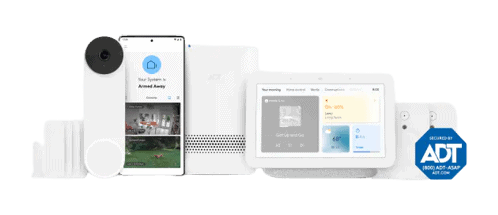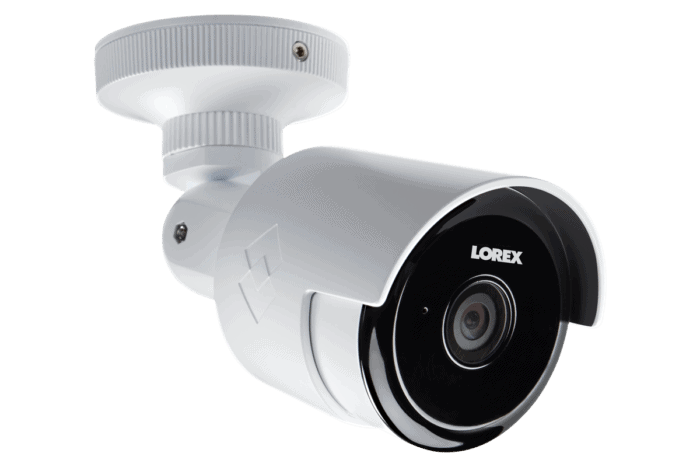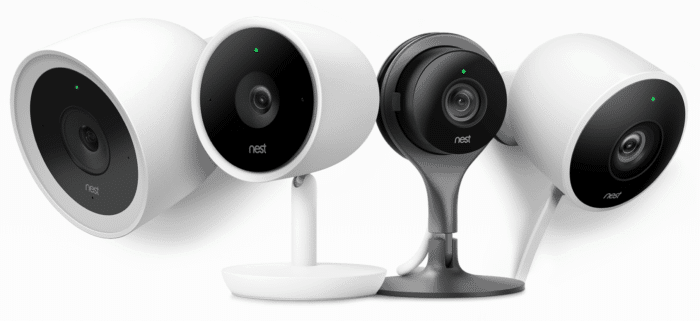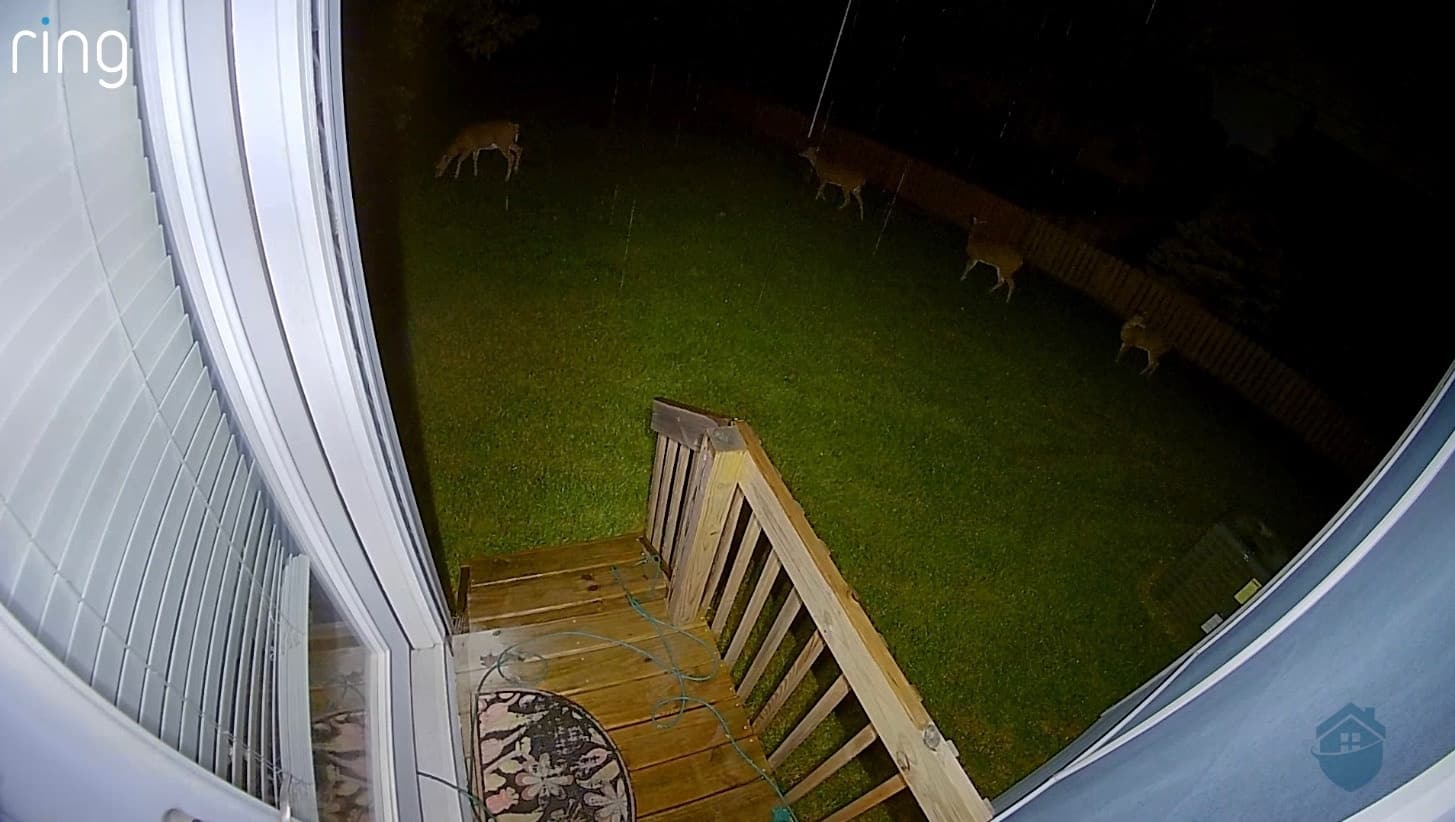Best Motion Sensor Security Cameras
ADT’s partnership with Google brought industry-leading professional monitoring to facial recognition cameras with intelligent motion sensing.

SafeHome.org may receive compensation from some providers listed on this page. Learn More
We may receive compensation from some providers listed on this page. Learn More

The new Google Nest Cams that ADT offers have built-in facial recognition capabilities that can power useful automation features. ADT’s Trusted Neighbor feature takes full advantage of this allowing you to create custom rules based on who’s at the door.

Known for their well-built, well-designed equipment, Lorex leads the industry in terms of motion-detection cameras. With a deep bench of security cameras suited, Lorex is a great option when you need to keep an eye on things.

Google Nest makes some of the smartest security products, including high-tech cameras that outshine the competition in motion sensing. With a Nest Aware subscription, the Nest’s Cam IQ comes alive with artificial intelligence facial recognition and other advanced features.



Editor’s Note: If you’re serious about securing your home, don’t just stop at getting a motion sensor camera. Instead, opt for a home security system AND a security camera for more robust protection. Find the best package deal on our best home security systems page.
We always say that security cameras are our eyes at home when we’re away, but what good are those eyes if they stand idly by as intruders ransack your belongings? That’s why we recommend buying security cameras with motion detection.
Simply having that feature doesn’t cut it though. Did you know there are different types of motion detection? There’s computer vision that detects changes at the pixel level; there’s PIR that uses heat signatures to detect movement; and there’s smart motion detection that uses PIR to detect movement and confirms if it’s a moving person, animal, or vehicle using AI.
Here’s a list of security camera brands that offer excellent motion detection, headlined by Lorex. We like it because it offers options for those different types, making it the most versatile. But keep reading why we also recommend Google Nest, Ring, Arlo, Blink, and Kuna, and how we picked those options.
Just as motion detection needs to be reliable, our recommendations need to be reliable too. That’s why we invested our time, money, and energy building this list. We didn’t just throw together a bunch of big-name security camera brands. We tested their products in our houses. We even performed simulations to see how well they can detect potential intruders and ignore false alarms.
Our testing period lasted over two months, and we focused it on more than just motion detection. In fact, we looked at three specific criteria:
Looking at those criteria, and by going through the buying and installation process, we feel that we’ve accurately gauged each brand we recommended on this list. Add to that our decades of home security experience, and you’ll find the most comprehensive guide on the internet. We’re not just giving out general advice though. As you read through our list, you’ll find cameras tailored specifically to your security needs.

There’s a reason ADT’s been able to last in the home security industry for 150 years and that’s because they know what they’re doing. Everything from the equipment to the installation to the optional professional monitoring is top notch. Their recent partnership with Google Nest just made things better.

The Google Nest Cams we bought with our ADT security system sent us alerts telling us who they saw.
All of ADT’s equipment can be DIY installed, nowadays, aside from the Google Nest Cam with floodlight which requires the help of an electrician. They still offer professional monitoring, but we generally recommend the DIY-route so you can avoid long-term contracts and that lowers their monitoring rate too. The ADT system we tested took about 45 minutes to install.
We know ADT’s not the only provider on this list to offer cameras with facial recognition. But, ADT makes the best use of that facial recognition through their Trusted Neighbor feature. That allows you to automate your home security system based on who your cameras see so you can allow someone you trust to enter your home during alarms and see what’s going on. We even used it to let our dog walker in our home every Thursday at 10:30 AM. This feature is why ADT sits at the top of our list of the best smart home security systems.
>> Learn About: ADT Self Setup Review and Pricing Plans in 2025
FYI: The ADT monitoring plan that supports security cameras comes with a Nest Aware subscription. That unlocks all of the capabilities of your Nest Cams and gives them cloud storage to record up to 30 days of video events. They also have an hour of backup internal storage so if your internet goes down, your cameras can still record footage.
| Connectivity | Wi-Fi |
|---|---|
| Power | Wired and battery |
| Field of View | Up to 135º |
| Resolution | 1080p |
| Storage | Limited local, cloud included |
| Smart Platform Compatibility | Alexa and Google Home |


Lorex knows home security cameras. They don’t sell entry sensors, smoke detectors, or keypads. They don’t offer monitoring either. They just make home security cameras. So as you might expect, they’re pretty good at it. First, they offer an enormous selection – bullet cameras, pan-and-tilt cameras, PoE cameras, indoor cameras, outdoor cameras…the list is seemingly endless. In fact, it’s easy to get overwhelmed trying to decide which one is right for you. This isn’t a case of quantity over quality, though. Lorex cameras are well-made and reliable, with a wide range of high-tech options.
Lorex offers dozens of camera models, but at the moment we’re particularly smitten with the A4, which features Lorex’s new Smart Motion Detection system. The A4 doesn’t just detect motion. It can distinguish moving objects based on how they move. Turns out bicycles don’t move like cars and squirrels don’t move like people. The A4 is smart enough to know which objects represent actual threats, which means you only get alerts that actually matter. As if that weren’t enough, the A4 also listens for threats so it can detect problems even if they’re off-screen.
| Type of Detection | How it Works |
|---|---|
| Standard motion detection | These systems pick up any type of movement, whether that’s a person, an animal, a vehicle, or an object. Using the Lorex app, the sensitivity can be customized, and specific motion zones can be set up. |
| PIR motion detection | PIR, or passive infrared motion detection, will trigger when it detects a heat signature. People, animals, and vehicles will set them off. |
| Advanced motion detection | Using AI, advanced motion detection will only trigger when it detects a person or a vehicle. This helps cut down on unwanted, unnecessary motion alerts and recording. |
| Smart Motion Detection | Smart Motion Detection will differentiate between people and vehicles, and you can set up separate alerts for both. |
| Smart Motion Detection Plus | Like the former, but add facial recognition. With Smart Motion Detection Plus, you can set your camera to only record if a face is detected — meaning someone is walking toward the camera — rather than, say, a person walking their dog past your home. |
One reason Lorex sits near the top of our list is that it’s exclusively focused on home security cameras. It doesn’t offer entry sensors or smoke detectors. It doesn’t sell whole home security packages or provide professional monitoring plans. If you’re looking for cameras that include those features, you’ll need to look elsewhere. If you’re looking to purchase a stand-alone camera, though, or create a home security system made up entirely of cameras, you really can’t do any better than Lorex.
Plus, Lorex makes it easy to self-monitor your system. During our testing, we got real-time alerts as well as access to both live footage and recorded footage. That’s right, we had playback options without having to sign up for a cloud storage plan. Lorex actually offers several different local storage systems, including DVR, NVR, and microSD cards.
With such an extensive inventory, you can always find a Lorex camera that suits your price range. For more, check out our list of Lorex’s prices and products.
| Connectivity | Wi-Fi, Ethernet, or PoE |
|---|---|
| Power | Wired, battery, or PoE |
| Field of View | Up to 180° |
| Resolution | Up to 4K |
| Storage | Free local, optional cloud |
| Smart Platform Compatibility | Alexa and Google Home |


Nest’s camera lineup isn’t quite as robust as that of Lorex, but you don’t need a lot of options if you got all the high-tech functions you could ever need. Motion detection? Of course. Person detection, too, and even facial recognition. Train your camera to recognize frequent visitors, and you’ll know exactly who's at your door any time you get an alert. Plus, like the Lorex A4, Nest cameras listen for trouble as well as look for it. Barking dogs, crying babies, screaming smoke alarms – you know what’s happening at your house even if it’s not happening in front of your camera.
Google Nest impressed us with its many high-tech features. The company sells just three cameras — the wired indoor Nest Cam, the battery-powered indoor/outdoor Nest Cam, and the wired Nest Cam with Floodlight – but all three come loaded with sophisticated AI that not only makes you safer but makes home security easier.
Of course, all three cameras include motion detection, and all three can tell the difference between people and other types of objects. As we mentioned earlier, that cuts down on false alerts, and fewer false alerts makes you more likely to pay attention when your system contacts you. Person detection is so last year, though. Google Nest Cams also come with facial recognition. No, they’re not connected to an FBI database or anything like that, but we were able to teach our Cam with Floodlight to recognize our friends and neighbors.
Technology isn’t cheap, and Nest charges about twice what you’d pay for comparable Ring cameras. The Nest Indoor, for example, is $99, while the Nest Spotlight we tested was $279. In addition, you’ll need a a Nest Aware monthly subscription if you want to unlock advanced features like facial recognition. Nest’s lowest-priced plan is $8 a month. You’re never going to get something for nothing, though, and Nest’s value more than justifies its prices.
Check out our Google Nest Cam review to get the full scoop on our live Nest tests.
| Connectivity | Wi-fi |
|---|---|
| Power | Wired |
| Field of View | Up to 130° |
| Resolution | 1080p |
| Storage | Cloud |
| Smart Platform Compatibility | Alexa and Google Home |


Ring offers whole home security systems including the option for professional monitoring. The company began life, though, as a security camera company, and it makes some great ones. All ring cameras feature motion detection and most include AI that can cut down on false alerts. Plus, the company is always innovating. Recent additions to its product line include the Ring Spotlight Cam and the Floodlight Cam. Outdoor illumination enhances motion detection at night and, as a bonus, can startle would-be home invaders away from doors and windows.
Pro Tip: If you’re looking to nail down the differences between the two, we put the Ring Floodlight and Spotlight cams up against each other, head to head.
Ring cameras don’t include facial recognition software, but they do come equipped with People Only Mode, and that’s really more important to your security. Without that, we’d get alerts every thirty seconds or so, all triggered by our neighbor’s cat who likes to lounge on our front porch. At some point, we’d just start ignoring them, and that would put our home’s security at risk. When you only get alerts that matter, you’re going to be safer.
In fact, Ring’s motion detection also includes customized motion zones, so they don’t pick up activity in your neighbor’s yard. And, with customized scheduling, you can make sure motion detection is off at 5 am when the street sweeper comes by. Ring’s cameras are also smart enough to trim video footage for you automatically, so you don’t have to scroll through video to find out what happened. All of these features improved our overall security, and after all, that’s why we buy home security systems in the first place.
Want to know more? Check out our Ring Cam analysis for a complete review.
| Connectivity | Wi-fi, ethernet |
|---|---|
| Power | Wired, battery, PoE |
| Field of View | Up to 140° |
| Resolution | Up to 1080p |
| Storage | Cloud |
| Smart Platform Compatibility | Alexa and Google Home |


Arlo home security cameras have a lot going for them, including reliable motion detection. They’ve got something else that’s essential as well: the ability to withstand the weather. No matter how smart a camera may be, if it goes out when there’s a snowstorm, it can’t keep you 100 percent safe. While we were testing an Arlo system, we dealt with not one but two violent storms in three days. Wasn’t a problem. Not only was our footage crystal clear, but we got system alerts the same as we did under blue skies. We added an Arlo Smart plan and in addition to real-time alerts, got 30 days of cloud storage for video clips.
Motion detection works best when it’s attached to a camera capable of recording in high resolution. After all, what difference does it make if you know something happened at your house if the image is so fuzzy you can’t make it out what it is. As we note in our review of the Arlo Pro 4, this camera’s 2K video gave us a crystal-clear view of absolutely everything in and around our home. It wasn’t just that we knew who was out our door. The Pro 4 captured enough detail to identify the reckless driver who had been terrorizing the neighbors. Once the police had the license plate, we didn’t have to worry about cats – and kids – on our street being in peril. The new Arlo Pro 5S offers this same 2K clarity.
As a bonus, Arlo’s motion sensor technology and high-resolution cameras are all totally wire-free. That means they don’t need wires to communicate with other system components, and they don’t need wires to receive power. That’s particularly useful outdoors, since it means you can place cameras out of reach of potential burglars. Oh, and did we mention these cameras are stylish? Don’t get us wrong – security is the priority, but if you can get security that improves the look of your home, why wouldn’t you? Find out everything you need to know about Arlo’s equipment costs and monitoring in our complete price guide.
| Connectivity | Wi-fi, Ethernet |
|---|---|
| Power | Wired, battery, PoE |
| Field of View | Up to 180° |
| Resolution | Up to 2160p |
| Storage | Cloud |
| Smart Platform Compatibility | Alexa and Google Home |


Plenty of reviewers out there have pigeon-holed Blink as an “entry-level” home security system. Nothing wrong with that – the industry definitely needs systems like that. The thing is, that description doesn’t quite do justice to these powerful cameras. In our Blink system review, we were impressed by these devices’ outstanding powerful motion sensors and outstanding video quality. Just as importantly, these cameras are completely wire-free – no power cords and no communication cords. That means you can put them anywhere. When you can put your cameras in the best possible locations, without worrying about wires, you’re necessarily going to be safer.As for the motion detection itself, it handled nicely. The default setting is particularly sensitive – that’s true of most of these cameras – but it was easy enough to adjust this sensitivity using the slider in Blink’s app.
We sometimes get so caught up in talking about fancy motion security tech that we don’t have time to mention other important camera features. One thing Blink does especially well, though, is manufacture customer-friendly products. Complex internal software and the latest gadgetry can actually be frustrating rather than helpful if it’s too complicated to use. You want lots of control over your devices. The more adjustments you can make, the better your cameras will perform. If you can’t figure out how to make those adjustments, though, what good are they? Blink manages to strike a perfect balance between control and ease of use.
One nice side-effect of simplicity? Blink is eminently affordable. In fact, no camera in Blink’s suite is more than $140. Of course, you get what you pay for, and these cameras don’t have extras like fine-tuned motion alerts or color night vision. These cameras provide great basic security, though, at a price point that’s within reach of almost anyone. Here’s the breakdown:
| Blink Camera | Regular Price |
|---|---|
| Blink Outdoor 4 | $99.99 |
| Blink Mini | $29.99 |
| Blink Mini Pan/Tilt | $39.99 |
| Blink Floodlight | $129.98 |
| Blink Wired Floodlight | $89.99 |
| Connectivity | Wi-fi |
|---|---|
| Power | Battery |
| Field of View | Up to 143° |
| Resolution | Up to 1080p |
| Storage | Cloud |
| Smart Platform Compatibility | Alexa |


Kuna does things differently from the rest of the industry. The company only sells cameras combined with outdoor light fixtures. Lenses are located in subtle spots that can be missed by the average home invader, or by the average home guest. That means you don’t have to sacrifice your decor for security and you can catch would-be thieves unaware. Some homeowners like the idea that anyone who happens by knows without a doubt that their property is protected, though. If you like things more surreptitious, Kuna is perfect. Plus, you get a choice of a high-tech floodlight or an old-fashioned Dickensian lantern. Both contain sensors that can detect motion up to 70 feet away.
We’ve talked several times already about just how important it is to choose a camera with motion detection that can tell the difference between people and other sorts of movement. Kuna cameras can do that. They can also differentiate between people, pets, vehicles, and packages. You can set your Kuna camera to screen out everything but people, or you can set it to let you know when that important package you’ve been waiting for arrives.
Supposedly, these devices will also eventually be able to tell the difference between people in your home and detect burglars based solely on their physical behaviors. And you won’t have to invest in new models to take advantage of these features. Your current camera should evolve over time. There aren’t many devices you can buy these days that actually improve the longer you have them.
Kuna’s light-camera models also gave us extra options when responding to motion-triggered events. When our camera picked up motion on the front porch at 2 am, we were able to shine a light on the situation. Turns out, a neighborhood possum was making its rounds, but once our light came on, it sauntered on its way. We controlled everything from the Kuna app, which meant we could both pull up video and react in real time, and we could have done that even if we were on vacation on the other side of the world. Want to know more? Check out our complete Kuna camera live testing guide to learn all the ins and outs of this system and see if this camera makes sense for you.
We’ll confess that we’d like to see Kuna offer more straightforward camera models. It’s not that we don’t like their lighting/camera combos, but we like their cameras so much that it would be nice to have options. Would it kill them, for instance, to manufacture a camera we could use in our living rooms? At a minimum, we’d like to see more options when it comes to their light fixture models. Still, this is a company that found a unique niche and they occupy it well.
| Connectivity | Wi-fi |
|---|---|
| Power | Wired, battery |
| Field of View | Up to 155° |
| Resolution | Up to 1080p |
| Storage | Cloud |
| Smart Platform Compatibility | Alexa and Google Home |
Since it’s really the backbone of any security camera, you’re going to want a camera with effective motion detection. The most common motion sensor we see in cameras is a passive infrared (PIR) sensor, which detects heat (infrared energy) that humans and animals release from their bodies.
You can’t have truly effective motion detection without decent night vision in today’s security cameras. Have a look at what we discovered when we installed a Ring Floodlight Camera in our backyard:

A family of deer travels across our property.
Not every camera out there has color night vision, though, so you might not get crisp images like this in every motion sensor camera. Arlo’s cameras have full color night vision, too, but you do get what you pay for with those, and the price is not necessarily cheap.
Every security camera comes with an app these days – as an iPhone user, we’ve found that they’re by and large easy to use across most brands. The best apps we’ve used present the camera’s motion detection features in an intuitive, logical way, so when we check on what time our kids’ school bus arrives, it takes us just a swipe or two to locate the footage.
FYI: We’ve identified the highest-rated home security cameras and ranked them on performance, features, pricing, ease of installation, and more. Check out our top-rated security cameras to find the perfect match.
The majority of security cameras, under the most ideal conditions, will record video at 1080p HD resolution. You’ll see it most often when your Wi-Fi signal is running at full strength.
But getting the best motion detection from your cameras doesn’t necessarily require a high video resolution, so remember that a super or ultra HD resolution (2K or 4K) camera like the Arlo Ultra 2 or Arlo Pro 5S might not detect motion any better than, say, a 1080p Blink Outdoor cam.
Another important component of motion-sensing cameras is the viewing angle, or field of view. This, in layman’s terms, is the angle between the two horizontal edges of the camera’s display.
The smaller the view, the less motion you’re going to capture from your camera. This is a crucial thing to consider in cameras, as not all viewing angles are the same. Ring’s 110-degree Indoor cam, for example, won’t get you the same viewing possibilities as the E1 Outdoor, one of Reolink’s cameras. With PTZ action, you can stretch out that view to a whopping 350 degrees.
With smart home automation features, security cameras are now functioning less as standalone devices and more like components in a larger smart home setup. For the most part, security cameras today are compatible with at least two smart home platforms. Usually, that’s Amazon Alexa and Google Home.But many other cameras, including Zmodo’s super affordable cameras and Swann’s NVR-based systems, are compatible with Z-Wave, Apple HomeKit, IFTTT, and other smart home ecosystems, too.
FYI: Our comprehensive Home Automation Guide has lots more information on integrating cameras into your smart home.
So what have we learned? First, while all motion sensors work the same way in principle, when you put them into security cameras, there’s sometimes a huge difference in quality. The technology you pack in there with the sensor translates what the sensor sees and what it does with that information can be impressive or just ho hum.
While our favorite motion sensing security cameras come from ADT, it’s not going to be the best solution for everyone. When you add in factors like camera placement, storage options, and video quality it can get complicated sorting out who’s the best. We’re confident, though, that the camera that’s right for you is somewhere on this list.